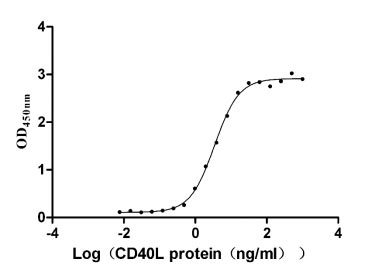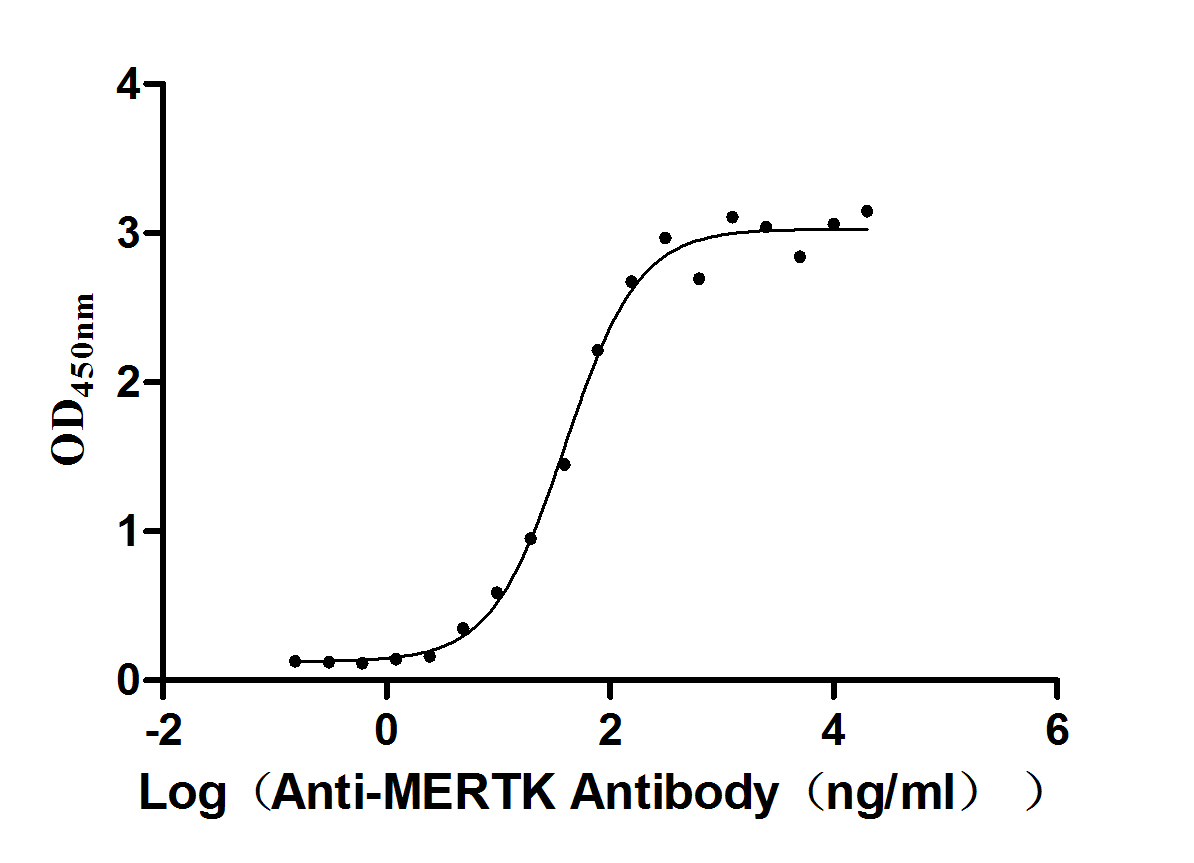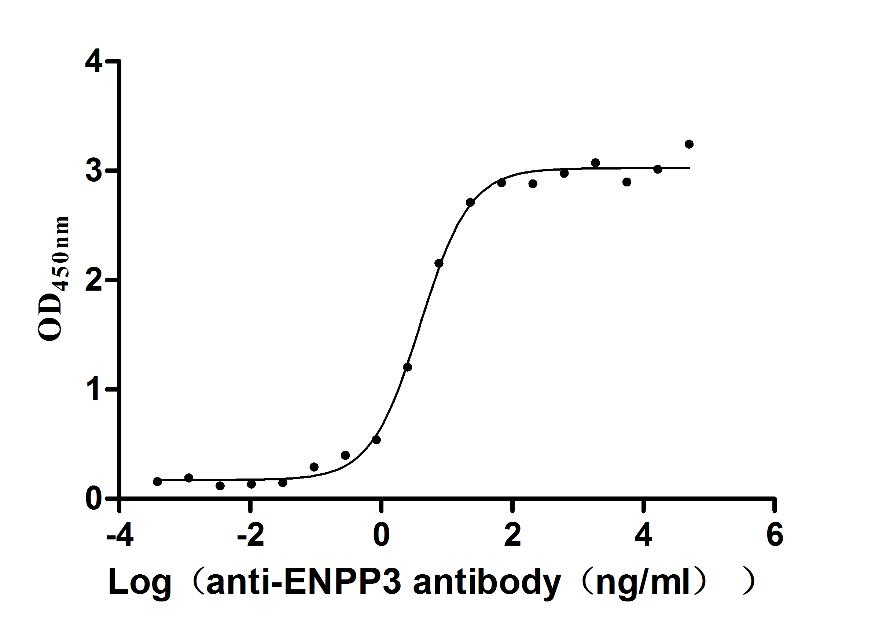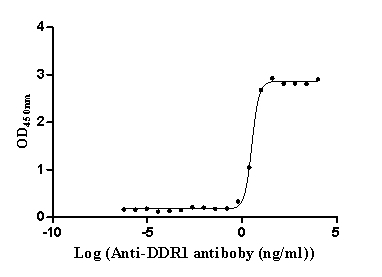Recombinant Mouse Transcription factor A, mitochondrial (Tfam)
-
中文名稱:小鼠Tfam重組蛋白
-
貨號(hào):CSB-YP023413MO
-
規(guī)格:
-
來(lái)源:Yeast
-
其他:
-
中文名稱:小鼠Tfam重組蛋白
-
貨號(hào):CSB-EP023413MO-B
-
規(guī)格:
-
來(lái)源:E.coli
-
共軛:Avi-tag Biotinylated
E. coli biotin ligase (BirA) is highly specific in covalently attaching biotin to the 15 amino acid AviTag peptide. This recombinant protein was biotinylated in vivo by AviTag-BirA technology, which method is BriA catalyzes amide linkage between the biotin and the specific lysine of the AviTag.
-
其他:
-
中文名稱:小鼠Tfam重組蛋白
-
貨號(hào):CSB-BP023413MO
-
規(guī)格:
-
來(lái)源:Baculovirus
-
其他:
-
中文名稱:小鼠Tfam重組蛋白
-
貨號(hào):CSB-MP023413MO
-
規(guī)格:
-
來(lái)源:Mammalian cell
-
其他:
產(chǎn)品詳情
-
純度:>85% (SDS-PAGE)
-
基因名:Tfam
-
Uniprot No.:
-
別名:Tfam; Hmgts; Transcription factor A; mitochondrial; mtTFA; Testis-specific high mobility group protein; TS-HMG
-
種屬:Mus musculus (Mouse)
-
蛋白長(zhǎng)度:Full Length of Mature Protein
-
表達(dá)區(qū)域:43-243
-
氨基酸序列SSMGSYPK KPMSSYLRFS TEQLPKFKAK HPDAKLSELV RKIAALWREL PEAEKKVYEA DFKAEWKAYK EAVSKYKEQL TPSQLMGMEK EARQRRLKKK ALVKRRELIL LGKPKRPRSA YNIYVSESFQ EAKDDSAQGK LKLVNEAWKN LSPEEKQAYI QLAKDDRIRY DNEMKSWEEQ MAEVGRSDLI RRSVKRSGDI SEH
-
蛋白標(biāo)簽:Tag?type?will?be?determined?during?the?manufacturing?process.
The tag type will be determined during production process. If you have specified tag type, please tell us and we will develop the specified tag preferentially. -
產(chǎn)品提供形式:Lyophilized powder
Note: We will preferentially ship the format that we have in stock, however, if you have any special requirement for the format, please remark your requirement when placing the order, we will prepare according to your demand. -
復(fù)溶:We recommend that this vial be briefly centrifuged prior to opening to bring the contents to the bottom. Please reconstitute protein in deionized sterile water to a concentration of 0.1-1.0 mg/mL.We recommend to add 5-50% of glycerol (final concentration) and aliquot for long-term storage at -20℃/-80℃. Our default final concentration of glycerol is 50%. Customers could use it as reference.
-
儲(chǔ)存條件:Store at -20°C/-80°C upon receipt, aliquoting is necessary for mutiple use. Avoid repeated freeze-thaw cycles.
-
保質(zhì)期:The shelf life is related to many factors, storage state, buffer ingredients, storage temperature and the stability of the protein itself.
Generally, the shelf life of liquid form is 6 months at -20°C/-80°C. The shelf life of lyophilized form is 12 months at -20°C/-80°C. -
貨期:Delivery time may differ from different purchasing way or location, please kindly consult your local distributors for specific delivery time.Note: All of our proteins are default shipped with normal blue ice packs, if you request to ship with dry ice, please communicate with us in advance and extra fees will be charged.
-
注意事項(xiàng):Repeated freezing and thawing is not recommended. Store working aliquots at 4°C for up to one week.
-
Datasheet :Please contact us to get it.
相關(guān)產(chǎn)品
靶點(diǎn)詳情
-
功能:Binds to the mitochondrial light strand promoter and functions in mitochondrial transcription regulation. Component of the mitochondrial transcription initiation complex, composed at least of TFB2M, TFAM and POLRMT that is required for basal transcription of mitochondrial DNA. In this complex, TFAM recruits POLRMT to a specific promoter whereas TFB2M induces structural changes in POLRMT to enable promoter opening and trapping of the DNA non-template strand. Required for accurate and efficient promoter recognition by the mitochondrial RNA polymerase. Promotes transcription initiation from the HSP1 and the light strand promoter by binding immediately upstream of transcriptional start sites. Is able to unwind DNA. Bends the mitochondrial light strand promoter DNA into a U-turn shape via its HMG boxes. Required for maintenance of normal levels of mitochondrial DNA. May play a role in organizing and compacting mitochondrial DNA.; May also function as a transcriptional activator or may have a structural role in the compaction of nuclear DNA during spermatogenesis.
-
基因功能參考文獻(xiàn):
- TFAM overexpression normalizes pathological hypertrophic factor NFAT4 in the presence of oxidative stress. PMID: 28800400
- results suggest a nucleation-cooperativity-based mechanism for sensitive detection of mitochondrial DNA and pathogen genomes, and identify HMGB/TFAM proteins as DNA-structuring host factors; they provide an explanation for the peculiar cGAS dimer structure and suggest that cGAS preferentially binds incomplete nucleoid-like structures or bent DNA PMID: 28902841
- TFAM is essential for transcription, replication and packaging of mtDNA into nucleoids. Tfam knockout mice display embryonic lethality secondary to severe mtDNA depletion. In this report, for the first time, we associate a homozygous variant in TFAM with a novel mtDNA depletion syndrome. PMID: 27448789
- Perturbation of mitochondrial complex function by ablation of the mitochondrial transcription factor A (Tfam) reproduces multiple hallmarks of aging in hippocampal neurogenesis. PMID: 28111078
- During muscle differentiation, Tfam protein levels are regulated by the availability of Tfam mRNA, which is controlled by both transcription and mRNA stability. PMID: 26182383
- TFAM binds to RNA-containing 4-way junctions but does not bind appreciably to RNA hairpins, internal loops, or linear RNA:DNA hybrids. PMID: 26545237
- Data show that mitochondrial transcription factor A (TFAM) packages single mitochondrial DNA (mtDNA) molecules. PMID: 26305956
- There was upregulation of mtDNA and TFAM in 6-wk diabetic mice, suggesting that TFAM activation could be a therapeutic strategy to treat peripheral neuropathy. PMID: 25944881
- This study demonistrated that Tfam gene inactive patkinsin disease cause dopamine loss and circadian rhythm disorder. PMID: 25171792
- Mitochondrial transcription factor A, an endogenous danger signal, promotes TNFalpha release via RAGE- and TLR9-responsive plasmacytoid dendritic cells. PMID: 23951313
- overexpression of TFAM can restore mitochondrial function to normal levels in NYGGF4-overexpressing adipocytes PMID: 23274913
- Acute exercise induces tumour suppressor protein p53 translocation to the mitochondria and promotes a p53-Tfam-mitochondrial DNA complex in skeletal muscle. PMID: 23690562
- Data indicate that TFAM-deficient keratinocytes failed to generate mitochondria-derived reactive oxygen species, and prevented the transmission of Notch and beta-catenin signals for epidermal differentiation and hair follicle development. PMID: 23386745
- The reduction of mitochondrial transcription factor A (TFAM) in adipose tissue increases mitochondria oxidation capacity due to complex I deficiency and greater uncoupling. PMID: 23168219
- Data suggest that microRNA 494 regulates mitochondrial biogenesis by down-regulating mtTFA (mitochondrial transcription factor A) and Foxj3 (forkhead box J3 protein) during myocyte differentiation and skeletal muscle adaptation to physical exercise. PMID: 23047984
- disruption of mitochondrial function by selective deletion of the Tfam gene in midbrain DA neurons results in physiological changes in the nigrostriatal circuitry that occur before the onset of locomotor impairments of Parkinson disease. PMID: 21233488
- TFAM overexpression can reduce mitochondrial permeability transition and ameliorate delayed neuronal death in the hippocampus after transient forebrain ischemia PMID: 20102525
- The MitoPark mouse, in which the mitochondrial transcription factor Tfam is selectively removed in midbrain dopamine (DA) neurons, is a genetic model for Parkinson's disease and response to levodopa. PMID: 20002202
- TFAM induces a structural change of the promoter that is required for POLRMT-dependent promoter recognition PMID: 15526033
- Accumulation of TFAM protein after H2O2 stress contributes to the regeneration of the mtDNA pool but that other mechanisms, independent from the TFAM protein amount have to be postulated to explain the proliferation of the mtDNA pool after GSH depletion. PMID: 16439064
- These results indicate that TFAM alone is sufficient to organize mitochondrial chromatin and provide a mechanism for nucleoid formation. PMID: 17581862
顯示更多
收起更多
-
亞細(xì)胞定位:[Isoform Mitochondrial]: Mitochondrion. Mitochondrion matrix, mitochondrion nucleoid.; [Isoform Nuclear]: Nucleus.
-
組織特異性:The mitochondrial isoform is widely expressed while the nuclear isoform is testis-specific.
-
數(shù)據(jù)庫(kù)鏈接:
Most popular with customers
-
Recombinant Human ICOS ligand (ICOSLG), partial (Active)
Express system: Mammalian cell
Species: Homo sapiens (Human)
-
Recombinant Human Tumor necrosis factor receptor superfamily member 5 (CD40), partial (Active)
Express system: Mammalian cell
Species: Homo sapiens (Human)
-
Recombinant Human Tyrosine-protein kinase Mer (MERTK), partial (Active)
Express system: Mammalian cell
Species: Homo sapiens (Human)
-
Recombinant Mouse Microtubule-associated protein tau (Mapt) (Active)
Express system: Mammalian cell
Species: Mus musculus (Mouse)
-
Express system: Mammalian cell
Species: Macaca fascicularis (Crab-eating macaque) (Cynomolgus monkey)
-
Recombinant Human Epithelial discoidin domain-containing receptor 1 (DDR1), partial (Active)
Express system: Mammalian cell
Species: Homo sapiens (Human)
-
Recombinant Human CUB domain-containing protein 1 (CDCP1), partial (Active)
Express system: Mammalian cell
Species: Homo sapiens (Human)



















